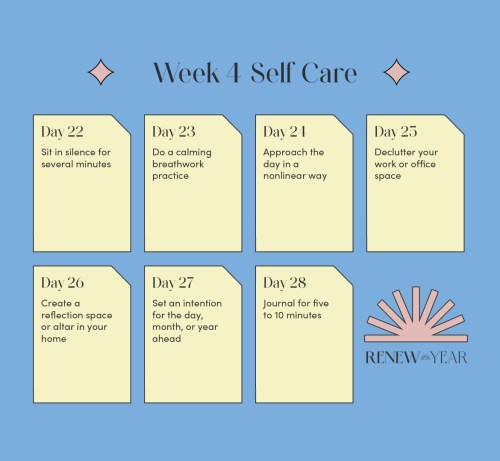Our editors independently select these products. Making a purchase through our links may earn Well+Good a commission
7 Steps To Get Clear on What You Want To Achieve and How You Want To Feel This Year
Meditation teacher Kimberly Snyder shares simple tips for learning how to connect with your purpose and listen to your intuition this year.

Part of the reason New Year’s resolutions can be so tough to maintain is that they become detached from their real meaning. Maybe on the surface, your resolution is to make $20,000 more this year or to exercise every day. But in order to align your actions with that goal, you may need to identify the real reason why you have it in the first place. That is, why do you want to increase your earnings or your fitness? Is it that you want to feel more free? Or more energetic? Learning how to connect with your underlying purpose (and tune out the external noise) is a big part of growing spiritually and leading a life in greater alignment.
When we connect with the energy inside of us or the voice of our intuition, we feel more natural joy, peace, and confidence.
It’s important to remember that we are all more than what we look like and what we do. If we assign outsize value to the egoistic, physical parts of ourselves, we open ourselves up to more suffering because these elements will always change. By contrast, when we connect with the energy inside of us or the voice of our intuition, we feel more natural joy, peace, and confidence in our everyday lives. And this connection to our true self is, in turn, what empowers us to pursue our goals, big and small, with less friction and more ease.
Finding this level of clarity around who you are and how you want to feel is a lifelong journey, but you can start by drawing more awareness and intentionality to your everyday actions. For the final week of our self-care-focused program, I’ve compiled my favorite tips for doing just that.

Day 22: Sit in silence for several minutes
The first step to understanding how you want to feel and why you want to feel that way is giving yourself the space and time to hear your inner voice. To do so, I suggest setting aside 10 minutes today during which you don’t talk or listen to anything external.
It’s common practice for many people to fill even the gaps in their days with external noise. Perhaps you listen to a podcast or music on your commute, or the news is on the TV in the background while you’re preparing a meal, or you’re scrolling through social media during your lunch break. All of this just makes it easier to get led astray by comparisons to others.
By instead committing to a block of actual silence, you’re giving yourself the auditory space to reconnect with yourself and to do something I call “feel your anchor” or feel grounded.
Day 23: Do a calming breathwork practice
We’re all so busy these days, it’s easy to move through life without even so much as a moment of stillness. But when we touch stillness and silence as a real experience, it starts to expand in our lives. In the most basic sense, stillness happens in the micro-gaps between our inhales and exhales, which is why I created a breathwork practice called “Expanding the Gaps”—specifically designed to draw your attention to those micro-gaps—for my latest book You Are More Than You Think You Are.
Today, I suggest engaging in this practice for five to 10 minutes in the morning to start your day, at the end of the day before bed, or at both times. Here’s how to do it in six steps:
- 1.Take a comfortable seat, and lift your spine upright so that it’s fairly straight from your seat to the crown of your head. Make sure your head isn’t jutting forward (which is a common occurrence in today’s smartphone-saturated world).
- 2.Next, place all your concentration on your breath. Simply watch your breath flow in naturally with your inhales, and flow out naturally with your exhales. Don’t try to control it, count it, or manipulate it to be any kind of pattern. Just watch it.
- 3.It may be helpful for your mind to concentrate on a simple mantra, like “let go,” to stop the mind from wandering and to focus on the breathing. So when you inhale, you breathe in “let,” and when you exhale, you breathe out “go.” Don’t try to time the breath to the mantra, however; let the mantra follow the breath.
- 4.Start to pay extra attention to the gaps: the spaces between your inhales and exhales where your breath takes a natural pause. As you pay attention to your breath, it will start to naturally slow down, and the gaps between inhales and exhales will start to expand. Again, don’t try to force this. Just observe.
- 5.Try to keep your body very still, and don’t pay any attention to the little micro-movements of your body. Just breathe as softly and with as little physical movement as possible. Never hold your breath with force or refuse to take a breath if you need one. This should feel like a natural flow.
- 6.If your mind wanders, calmly but consistently come back to simply observing your breath. (Over time, it definitely becomes easier to keep the mind from wandering! I used to get very distracted during these practices, yet by going into them time and time again, I’ve found that I can maintain focus for longer and longer periods. This will be true for you, too, with regular practice.)
Day 24: Approach the day in a nonlinear way
Yes, there are certain things you probably need or want to get done on any given day for practical reasons. But if you can create just a little room for spontaneity in how these things happen, you may find that you can move through your list more easily or even that the actual things on the list change. What I mean by this is to approach the day nonlinearly—so, rather than running through your (mental or literal) to-do list in order, check in with how you feel, and let that guide your order of operations.
For example, if you’re feeling particularly creative in the morning, perhaps you give yourself permission to do something that involves creativity then, and to put off, say, emails or cleaning for later in the day. Or if you’re struggling to get going in the morning, maybe you start with a task that’s very well-ingrained in your muscle memory.
This way, rather than hammering through your to-do list in the same order as always (without regard for the natural fluctuations in your energy), you’re allowing yourself the opportunity to listen and respond to how your body feels, which is a key part of learning how to connect with your purpose.
Day 25: Declutter your home or office space
If you’ve ever cleaned up your physical space and felt lighter, clearer, or freer as a result, you already know how your environment can affect your overall mental outlook. That’s why I suggest using a few minutes today, at the midweek point of week four, to simply get rid of stuff you don’t need in one area of your home or office space.
Set a timer for 20 minutes, and dedicate that time to clearing up miscellaneous things that have amassed as visible clutter: Toss or donate what you honestly don’t need (or, to take a note from Marie Kondo, what no longer sparks joy) and decide on a permanent home for whatever you do. This will help clear mental space for new energy to occupy, too.
Day 26: Create a reflection space or altar in your home
Part of figuring out how to connect with your inner voice and purpose is building a ritual around quiet reflection. And creating a physical container for that ritual can add to its power by turning your concentration and energy toward it.
This is why I recommend dedicating a certain part of your home—even just a corner of a room—as an “altar,” focal point, or quiet reflection space that’s just a place for you to spend time with yourself, sit in silence, meditate, journal, or simply feel big feelings. This way, you’re honoring your right to a safe sanctuary available to you whenever you need or want it.
It might look like a small table with some framed pictures, candles, or objects that feel meaningful, like some shells or rocks you’ve found, or maybe it’s just a cushion on the floor. There aren’t any rules for what this space needs to be or include, other than that it feels sacred to you.
Day 27: Set an intention for the day, month, or year ahead
It’s difficult to attract what you want in this world if you’re murky on what that is. By this point in the week, you’ve created enough mental space to craft a clear intention for your future-you and turn an inner desire into words on paper. Once you create concrete language for that intention, your goals will have an anchor, too.
For example, as I shared on a recent episode of my Feel Good Podcast, one of my intentions is to connect more to my true self and to teach others how to do the same. And my goals—to put out new courses this year, to launch new podcasts—all flow from there. In this way, intention-setting can serve as a powerful technique to focus your energy.
Day 28: Journal for five to 10 minutes
On this final day of our self-care program, I’d like for you to revisit the intention you set yesterday and expand on it by journaling. If the intention you set was short-term, I also challenge you to set a bigger intention for the year ahead, around how you want to feel in your body and in your life. Begin by free-writing on this intention, and then use the prompts below to journal for an additional few minutes:
- What three qualities would I like to guide the year ahead?
- How can I use my energy, talents, and resources to serve others more this year?
- What energies, relationships, and old ideas or beliefs can I let go of today that are not in alignment with my intention?
Sign Up for Our Daily Newsletter
Get all the latest in wellness, trends, food, fitness, beauty, and more delivered right to your inbox.
Got it, you've been added to our email list.










